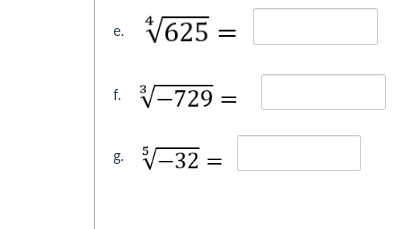4th root of 625, 3rd root of -729, and 5th root of -32

Understand the Problem
The question is asking for the calculation of different types of roots for the provided numbers. Specifically, it involves calculating the fourth root of 625, the cube root of -729, and the fifth root of -32.
Answer
- \( \sqrt[4]{625} = 5 \) - \( \sqrt[3]{-729} = -9 \) - \( \sqrt[5]{-32} = -2 \)
Answer for screen readers
- The fourth root of 625: ( \sqrt[4]{625} = 5 )
- The cube root of -729: ( \sqrt[3]{-729} = -9 )
- The fifth root of -32: ( \sqrt[5]{-32} = -2 )
Steps to Solve
- Calculate the fourth root of 625
To find the fourth root of 625, we want to determine a number ( x ) such that ( x^4 = 625 ).
Finding the prime factorization of 625: $$ 625 = 5^4 $$
Thus, $$ \sqrt[4]{625} = 5 $$
- Calculate the cube root of -729
The cube root of a negative number is defined and can be calculated as: $$ \sqrt[3]{-729} = -\sqrt[3]{729} $$
Finding ( \sqrt[3]{729} ): $$ 729 = 9^3 $$ Therefore, $$ \sqrt[3]{-729} = -9 $$
- Calculate the fifth root of -32
The fifth root of a negative number is: $$ \sqrt[5]{-32} = -\sqrt[5]{32} $$
Finding ( \sqrt[5]{32} ): $$ 32 = 2^5 $$ Thus, $$ \sqrt[5]{-32} = -2 $$
- The fourth root of 625: ( \sqrt[4]{625} = 5 )
- The cube root of -729: ( \sqrt[3]{-729} = -9 )
- The fifth root of -32: ( \sqrt[5]{-32} = -2 )
More Information
- The fourth root is the number that when multiplied by itself four times gives the original number.
- The cube root of a negative number results in a negative number.
- The fifth root follows the same principle, where the root's sign matches the number's sign.
Tips
- Confusing the roots' signs. Remember that the roots of negative numbers (like cube roots and fifth roots) can be negative when the root is odd.
- Not simplifying powers correctly when calculating roots.
AI-generated content may contain errors. Please verify critical information